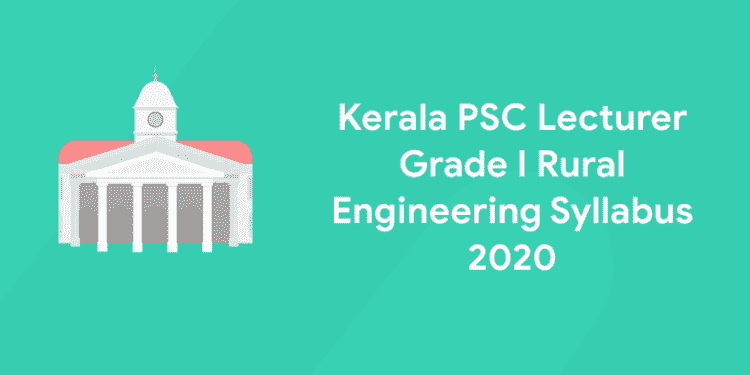Table of Contents
Exam dates for Kerala PSC Instructor Grade I Electrical Engineering 2020 exams is announced by the Kerala PSC. Eligible candidates can apply online on the One Time Registration Portal of Kerala PSC on or before 11-10-2020. Candidates appearing must start preparing now. Aspirants must be well aware of the syllabus and exam pattern. This will help you in drafting a very good study plan. With a proper study plan, guidance and hardwork one can easily crack any competitive exam. In this article we will provide the Kerala PSC Lecturer Grade I Rural Engineering Syllabus 2020.
Download Entri & attempt free Kerala PSC exam mock tests
Kerala PSC Lecturer Grade I Rural Engineering 2020 – Important Details
| Name of Post | Lecturer Grade I Rural Engineering |
| Department | Rural Development |
| Scale of Pay | Rs: 20740/ – 36,140/- |
| Number of Vacancies | 2 (Two) |
| Category Number | 068/2015 |
| Age Limit | 18-36 |
| Educational Qualification | B.Tech (Civil) Degree with at least 55% marks in the aggregate. |
| Last date for online submission | 11-10-2020 |
| Mode of Applying | Online |
| Date of Examination | 04.12.2020 Friday |
| Method of appointment | Direct Recruitment |
Kerala PSC Lecturer Grade I Rural Engineering 2020 – Exam Pattern
1: Which Year First Assembly Election was held in Kerala?
- Exam Type: Objective Multiple Choice
- Mode of Examination: OMR/Online
- Total Marks: 100
- Total time duration: 1 Hour 15 Minutes
Enroll in Kerala's Top-rated Kerala PSC Coaching Program!
സർക്കാർ ജോലി എന്ന സ്വപ്നം ഇനി സ്വപ്നം മാത്രമല്ല! Join Entri's Kerala PSC Coaching Programs
Join Now!Kerala PSC Lecturer Grade I Rural Engineering Syllabus 2020
Below given are the main topics that are included in the syllabus of Kerala PSC Lecturer Grade I Rural Engineering 2020-
Part I (a) – Technical Mathematics
Part I (b) – Basic Civil Engineering
Part I (c) – Basic Mechanical Engineering
Part I (d) – Basic Electrical Engineering
Part I (e) – Essentials of Electronics Engineering
Part II – Civil Engineering
Part I (a): Technical Mathematics
- Matrices – Identification of Matrices, matrix operations, adjoint and inverse.
- Determinants – Evaluation of second and third order, minors and cofactors, solutions of simultaneous linear equation in three unknown using Cramer’s rule.
- Binomial Series – Expansions using Binomial theorem.
- Trigonometric functions – Signs of functions in each quadrant. Trigonometric values of angles, properties of trigonometric functions, applications of the identities sin (A ± B), cos (A ± B) and tan (A ± B).
- Coordinate geometry – Equations to a straight line – slope-intercept form, intercept form, Angle between two lines, condition for two lines to be perpendicular, parallel.
- Differentiation – Limits and continuity, derivatives of functions, equation to tangents and normals. Maxima and minima of functions of one variable.
- Integration of functions – Integration of different types of functions.
- Applications of integration – Area bounded by a curve and X or Y axis, solutions of differential equations using the method of variable separable, solutions of linear differential equations of first order.
Part I (b): Basic Civil Engineering
- Materials:
Brick – varieties and strength, characteristics of good brick. Cement – varieties and grade of cement and its uses. Steel – types of steel for reinforcement bars, steel structural sections. Aggregates – types & requirements of good aggregates. Concrete – grades of concrete as per IS code, water cement ratio. Workability, mixing, batching, compaction and curing.
- Construction:
Parts of building – foundation – types of foundations – spread footing, isolated footing, combined footing, Raft, pile and well foundations. Masonry – types rubble masonry, brick masonry, English bond and Flemish bond. (One brick wall).
- Surveying:
Chain surveying – principles, instruments, ranging, and chaining survey lines, field work and field book, selection of survey stations, units of land area.
- Levelling:
Levelling instruments, different types, bench mark, reduced level of points, booking of field notes, reduction of levels by height of collimation method (simple problem). Modern survey – instruments – Total station, Electronics theodolite, Distomat.
Download Entri & get free monthly current affairs capsule and ace your exam preparation
Part I (c): Basic Mechanical Engineering
- The importance of IC Engines:
Definition, classification – two stroke engines, four stroke engines, working of two stroke engines and four stroke engines with the help of line sketches, comparison between two stroke and four stroke engines, comparison between petrol and diesel engines, function of fly wheel, clutch, gearbox, propeller shaft and differential in power transmission, explain with sketch the working of differential, briefly explain power transmission of 4 wheel vehicle with line diagram.
- The importance of Power Plants:
Introduction, classification of power plants – working of hydroelectric power plant with schematic sketches – working of thermal (Steam and Diesel) power plant with schematic sketches – working of nuclear power plant with schematic sketches.
Part I (d): Basic Electrical Engineering
- Review with discussion of electric current, potential difference, power, EMF, resistance and its laws, Ohms law and series parallel circuit, electromagnetism, generation of AC and DC supply.
- Idea of Basic electrical circuit:
Electrical supply and load and its functioning, division of voltage and current in a parallel and series circuit – simple problems, units of power and energy, solution of DC circuit with calculation of energy consumption in an installation.
- Circuit parameters:
Resistance, Capacitance and inductance. AC circuit with R, L, C. Simple solution of typical AC circuit with resistance, impedance, power and power factor.
- Electrical circuit of an installation: Earthing, lightning protection.
Part I (e): Essentials of Electronics Engineering
- Active and passive devices – review only. LED – working, applications, comparison of LED lighting and CFL lighting. Full wave rectifier – diagram and explanation, 5 V power supply – with bridge rectifier and 7805. SMPS – block diagram and advantages. Integrated circuits. SMDs – advantages. Static electricity – precautions in handling electronic circuits.
- Switches: ON / OFF, push to ON, push to OFF, push to ON / OFF, SPST, SPDT, DPDT. Working and application of limit switches, proximity switches, relays.
- Microcontrollers: Simple block diagram of 8 bit microcontrollers – application.
- Mobile technology: CDMA and GSM. Compare – 2G and 3G technologies.
- Inverter & UPS: Block diagram. Compare – inverter and UPS. Online and off line UPS – differentiate. Battery selection for UPS and inverter.
- E-waste: Health hazards of e-waste.
Civil Engineering
I Construction Engineering
- Structural Building Materials
- Ornamental Materials for Finishing
- Construction Technology
- Building Components
- Introduction to Construction Management
- Construction Planning: Construction
- Execution of Works
- Contracts
- Tender and Tender notices
- Payment of Bills
- Human Resource Management
- Stores
- Materials Management
- Construction Machinery
- Principles of Safety in Construction
- Entrepreneurship and Management
- Small Scale Industry
- Quality Management
- Environmental Hazards & Disasters
Download Entri & attempt free GK Quiz and ace your exam preparation
II Surveying & Quantity Surveying
- Quantity Surveying and Valuation
III Irrigation Fluid Mechanics and Environmental Engineering
- Nature and Scope of Irrigation Engineering
- Water requirement of Crop
- Hydrology
- Head Works
- Distribution works
- Methods of irrigation
- Fluid Mechanics
- Flow of Fluid
- Flow through orifices & Mouth Pieces
- Pumps
- Turbines
- Notches
- Weirs
- Hydro-electric Installation
- Water Supply Engineering
- Conveyance of water
- Purification of Water
- Distribution System
- Appurtenances in Distribution System
- Water Supply Arrangements in Building
- Sanitary Engineering
- Sewage Treatment and Disposal
IV Transportation and Geotechnical Engineering
- Road Engineering
- Investigation for Road Project
- Geometric Design of Highways
- Highway Construction
- Traffic Engineering
- Introduction
- Permanent way
- Laying and Maintenance
- Signalling and Interlocking
- Introduction
- Sub Structure
- Super Structure
- Tunnel Engineering
- Airport Engineering
- Docks and Harbours
Geotechnical Engineering
Nature of soil and fundamental relationship – Introduction of soil mechanics – soil Engineering – scope of soil engineering – History of development of soil mechanics – Soil types – residual and transported – soil as a three phase system – water content – unit weight of soil mass – bulk unit weight, dry unit weight, unit weight of solids, saturated unit weight, submerged unit weights – specific gravity – void ratio – porosity – degree of saturation – percentage air voids – air content – density index – functional relationships – problems.
Determination of index properties – water content by oven drying method – specific gravity using pycnometer and specific gravity bottle – particle size distribution – sieve analysis, hydrometer method – particle size distribution curve – consistency of soils – liquid limit, plastic limit, shrinkage limit, plasticity index, consistency index – determination of liquid limits, plastic limit & shrinkage limit – shrinkage ratio – field density by sand replacement method and the core cutter method, classification of soils Necessity – I. S. classification.
Soil water – classification – absorbed water – capillary water – stress condition in soil: Effective and neutral pressures – problems. Permeability of soil – Darcy’s law – discharge velocity and seepage velocity – factors affecting permeability – determination of coefficient of permeability – constant head permeability test – falling head permeability test – problems. Compaction of soil – Definition and objectives of compaction – Standard Proctor test and modified proctor test – concept of O.M.C and maximum dry density – Zero air voids line – field compaction methods – factors affecting compaction.
Site investigation and sub-soil exploration – objectives – site recognaissance – site exploration – depth of exploration – number and disposition of pits and boring – general exploration – detailed exploration – methods of site exploration – open excavations – boring methods – auger boring – auger and shell boring – wash boring – percussion boring – rotary boring – soil samples and samplers – disturbed sampling – undisturbed sampling – Standard Penetration Test – Geophysical. Bearing capacity – ultimate bearing capacity, safe bearing capacity and allowable bearing pressure – general and local shear failure – Terzaghi’s theory of bearing capacity – effect of water table – plate load test – limitations.
Foundations – different types of foundations – proportioning of foundations – rectangular and trapezoidal combined footings – strap footing – Raft foundation. Deep foundations – Pile foundation – necessity of pile foundation – classification of piles according to materials, mode of transfer of loads, method of installation, use and displacement of soil. Well foundations – shapes of wells and component parts – sell sinking – tilts and shifts – measures for rectification of tilts and shifts.
V Analysis and Design of Structures
- Forces and Moments
- Centre of Gravity
- Moment of Inertia
- Friction
- Simple Stresses and strains
- Temperature Stresses
- Strain Energy
- Beams and bending
- Thin Cylinders
- Columns and Struts
- Analysis of Trusses
- Theory of simple Bending
- Direct and Bending Stresses
- Dams and Retaining Walls
- Fixed Beams
- Deflection of Beams
- Continuous Beams
- Moment distribution method
- Design
Click here for official Kerala PSC Lecturer Grade I Rural Engineering Syllabus 2020 PDF
Other Important Links:
Kerala PSC Instructor Grade I Electrical Engineering Syllabus 2020
Weekly English Vocabulary Based on The Hindu Editorial 2020 October 02
How you can use Entri app for your exam preparation:
- Entri provides an online platform to help you prepare for competitive exams.
- Download for free of cost and get access to video classes, exams and study cards with a single subscription fee.
- You can access full length mock tests and previous year question papers and practice free monthly current affairs quiz.












